Krátký pohled do odpadového hospodářství Hong - Kongu
Hong Kong generates several different types of waste, and each has its own requirements for handling. The EPD keeps regular statistics on each waste type, such as composition, quantity sent for disposal and quantity recycled.
Municipal Solid Waste (MSW) comprises solid waste from households, commercial and industrial sources. This excludes construction and demolition waste, chemical waste and other special waste. MSW is disposed of at landfills.
Construction waste includes waste arising from such activities as construction, renovation, demolition, land excavation and road works. Ideally, the waste is separated and inert material is used as fill in reclamation sites, when available. However, a significant portion of the waste still goes to landfills.
Chemical waste comprises substances specified under the Waste Disposal (Chemical Waste) (General) Regulation as posing a possible risk to health and/or the environment.
Special wastes include clinical waste, animal carcasses, livestock waste, radioactive waste, grease trap waste and waterworks/sewage sludges. These wastes need to be treated separately. Some livestock waste is treated at the Sha Ling Composting Plant. Arrangements are being developed for the proper treatment and disposal of the other wastes, but more time is needed to address community concerns about such facilities.
Other solid waste comprises dredged mud and excavated materials disposed of at marine disposal sites.
THE CHALLENGES
Waste is a common problem of affluent societies. Especially when people can afford greater convenience and more purchases tend to throw away more rubbish. Hong Kong is no exception to this.
Growing Wasteloads 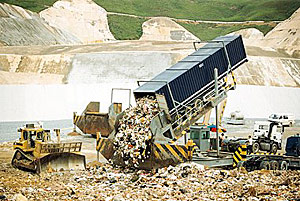 Hong Kong, like many developed places, has seen its wasteloads grow as its economy has grown. Municipal wasteloads have in general been increasing since 1986 - when the EPD was formed - mirroring Hong Kong's rapid economic expansion over the same period. At the same time, the population has grown by more than one million people and each person is throwing away more waste. The per capita level of municipal solid waste disposal has risen from 1.28 kilogrammes per person per day in 1991, to 1.36 kilogrammes in 2007.
Hong Kong, like many developed places, has seen its wasteloads grow as its economy has grown. Municipal wasteloads have in general been increasing since 1986 - when the EPD was formed - mirroring Hong Kong's rapid economic expansion over the same period. At the same time, the population has grown by more than one million people and each person is throwing away more waste. The per capita level of municipal solid waste disposal has risen from 1.28 kilogrammes per person per day in 1991, to 1.36 kilogrammes in 2007.
Municipal solid waste includes waste from households, industry and commercial operations, but landfills are also under tremendous pressure from construction waste.In 2006, the Government introduced the construction waste disposal charging scheme and the quantity of construction waste disposed of at landfills deceased from 6,560 tonnes per day in 2005 to 2,910 tonnes per day in 2007. This figure fluctuates depending on the economic situation and the number of construction projects underway.
Outlook
The continued growth in wasteloads means Hong Kong is running out of landfill space far earlier than expected, and the existing landfills will be filled up, one by one, in early to mid 2010s if waste levels continue to increase at current levels. Unless solutions are identified immediately, we could face a crisis in the next decade of having nowhere to put the thousands of tonnes of waste thrown away each day.
New landfill sites must be identified. However, the community has become more resistant to having waste facilities near their neighbourhoods. The government have already started to consult the public on the options.
Landfill space should also be conserved by state-of-the-art technologies that reduce the bulk volume of waste requiring disposal. After extensive review, the EPD is now planning to develop the Integrated Waste Management Facilities that would adopt advanced incineration as core technology to reduce bulk waste volume and to recover energy. Organic Waste Treatment Facilities are also being planned to recycle source-separated organic waste to useful products.
Cost is always a consideration. It has cost nearly $6 billion to build our three strategic landfills, and the operating cost of the three landfills is around $400 million per year. Some 4.9 million tonnes of waste were landfilled in 2008.
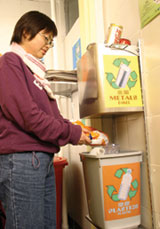 |
| Waste recycling in housing estate |
WASTE REDUCTION
Waste reduction is often associated with recycling, but it is more complex than that. Avoiding the generation of waste in the first place and minimising waste are also crucial measures in any waste reduction strategy.
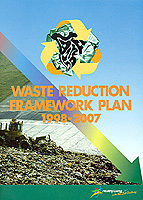 In 1998, the Government unveiled the Waste Reduction Framework Plan (WRFP), which sets out the various initiatives for waste reduction. The progress of the Plan was reviewed in 2001. It is found that although we have made some progress in the overall waste recovery rate, there is still room for improvement in different aspects in waste reduction and domestic waste recovery. The review recommends a series of measures to facilitate domestic waste separation and recovery in Hong Kong. The review also sets the following targets: (i) to raise the overall MSW waste recovery rate from 34% to 36% in 2004 and 40% in 2007; and (ii) to raise the domestic waste recovery rate from 8% to 14% in 2004 and 20% in 2007. The construction industry is also a major target and the aim is to reduce construction and demolition waste going to landfills by 25 per cent between 1999 and 2004.
In 1998, the Government unveiled the Waste Reduction Framework Plan (WRFP), which sets out the various initiatives for waste reduction. The progress of the Plan was reviewed in 2001. It is found that although we have made some progress in the overall waste recovery rate, there is still room for improvement in different aspects in waste reduction and domestic waste recovery. The review recommends a series of measures to facilitate domestic waste separation and recovery in Hong Kong. The review also sets the following targets: (i) to raise the overall MSW waste recovery rate from 34% to 36% in 2004 and 40% in 2007; and (ii) to raise the domestic waste recovery rate from 8% to 14% in 2004 and 20% in 2007. The construction industry is also a major target and the aim is to reduce construction and demolition waste going to landfills by 25 per cent between 1999 and 2004.
The Government has been working towards delivery of the targets set out in the WRFP. We are committed to reviewing the WRFP, and since we are approaching the end of the planning horizon of the WRFP, the Government has to formulate a new strategy. We recognise that the growing waste management problem requires continued effort both by the Government and the community at large. Separately, the Council for Sustainable Development (SDC) conducted an engagement process on three pilot areas, one of which is solid waste management, and published its report with recommendations on the engagement process in February 2005. In response to the SDC's recommendations, the Government published a first sustainable development strategy in May 2005. The Environmental Affairs Panel of the Legislative Council (LegCo) discussed in depth the waste management strategy on 28 February 2005 and 23 May 2005. On 5 July 2005, the EAP passed a motion to urge the Administration to include a holistic and comprehensive plan, targets and timeframes for measures in the upcoming strategy document on MSW management.
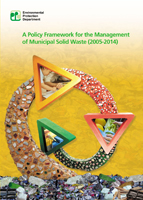 Taking into account the recommendations of the SDC's report and the views expressed by the EAP of the LegCo, the EPD published "A Policy Framework for the Management of Municipal Solid Waste in Hong Kong (2005-2014)" (the Policy Framework) in December 2005. The Policy Framework sets out the strategy and measures to address the MSW problem in Hong Kong in the next decade. The main vein of the strategy is to implement the polluter-pays principle through MSW charging and producer responsibility schemes (PRSs). The Policy Framework proposes simple, yet effective, economic tools that would create incentives for the community to recycle more and discard less. The public is sincerely invited to support the measures and milestones set out in the Policy Framework.
Taking into account the recommendations of the SDC's report and the views expressed by the EAP of the LegCo, the EPD published "A Policy Framework for the Management of Municipal Solid Waste in Hong Kong (2005-2014)" (the Policy Framework) in December 2005. The Policy Framework sets out the strategy and measures to address the MSW problem in Hong Kong in the next decade. The main vein of the strategy is to implement the polluter-pays principle through MSW charging and producer responsibility schemes (PRSs). The Policy Framework proposes simple, yet effective, economic tools that would create incentives for the community to recycle more and discard less. The public is sincerely invited to support the measures and milestones set out in the Policy Framework.
In May 2007, the EPD announced a proposal on an environmental levy on plastic shopping bags to reduce their indiscriminate use.
WASTE MANAGEMENT AND DISPOSAL
The EPD manages facilities for collecting, transferring, treating and disposing of a variety of waste types. Since 1989, the department has overseen the establishment of a Chemical Waste Treatment Centre, three strategic landfills and a network of refuse transfer stations. It has also phased out older, environmentally-unacceptable landfills, restored them to a safe condition and is in the process of developing them for different recreational uses, such as football pitches and golf courses.
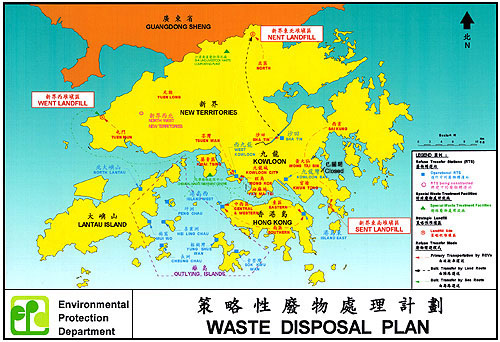
These waste facilities were built under the Waste Disposal Plan and cost more than $10 billion in total to build. The landfills initially were intended to last until 2020, but they could be full several years earlier if nothing is done to reduce wasteloads.
Waste is also managed through legislations. The Waste Disposal Ordinance is used to enforce controls on waste disposal, including collection and disposal and the import and export of waste. The Dumping at Sea Ordinance is enforced to control disposal of dredged mud and excavated materials at designated marine disposal sites. Livestock Waste Control Scheme has been fully implemented in the management and disposal of livestock waste.
The details of different types of waste management facilities are listed as follows :
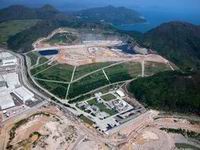 Three strategic landfills are located in the New Territories (Nim Wan, Tseung Kwan O and Ta Kwu Ling). Liners, leachate collection and treatment systems, landfill gas management systems, and surface and ground water management systems are in place to control air and water impacts.
Three strategic landfills are located in the New Territories (Nim Wan, Tseung Kwan O and Ta Kwu Ling). Liners, leachate collection and treatment systems, landfill gas management systems, and surface and ground water management systems are in place to control air and water impacts.
- Thirteen closed landfills in Hong Kong are being restored to minimise potential safety and health risks. They are landscaped to provide green zones and can be developed into different public recreational uses such as golf driving ranges and courses, multi-purpose grass pitches, recreational parks and ecological park.
- Seven refuse transfer stations are located in different areas in Hong Kong. These are centralised collection points for the transfer of waste to the strategic landfills. The waste from smaller refuse collection trucks is compacted and transferred into containers, which are loaded onto lorries or barges for shipment to landfills. The wastewater, odours and emissions from the stations are all controlled.
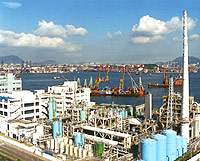 The Chemical Waste Treatment Centre on Tsing Yi Island opened in 1993 and accepts a variety of chemical wastes. It has extensive controls on its emissions which are regularly monitored by the EPD.
The Chemical Waste Treatment Centre on Tsing Yi Island opened in 1993 and accepts a variety of chemical wastes. It has extensive controls on its emissions which are regularly monitored by the EPD.
- The Sha Ling Composting Plant in the northern New Territories opened in 1991 and accepts livestock waste. The waste is composted into soil conditioner for use in Hong Kong.
WHAT YOU CAN DO  Individuals can reduce their waste by buying items with less packaging, using reusable bags for shopping, and separating waste paper, metals and plastics from our daily waste for recycling.
Individuals can reduce their waste by buying items with less packaging, using reusable bags for shopping, and separating waste paper, metals and plastics from our daily waste for recycling.
ZDROJ:www.epd.gov.hk
